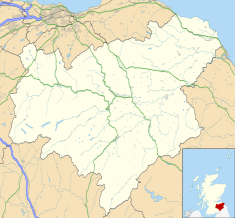The Glen, Scottish Borders
| The Glen | |
|---|---|

The Glen viewed from the hills to the south-east
|
|
| Coordinates | 55°35′09″N 3°06′55″W / 55.5858°N 3.1153°WCoordinates: 55°35′09″N 3°06′55″W / 55.5858°N 3.1153°W |
|
Listed Building – Category A
|
|
| Designated | 23 February 1971 |
| Reference no. | 19746 |
| Designated | 1987 |
The Glen, also known as Glen House, is an estate and country house in southern Scotland. It is located in the glen of the Quair Water, around 5 kilometres (3.1 mi) south-west of Innerleithen, and 9 kilometres (5.6 mi) south-east of Peebles, in the Scottish Borders. The estate is recorded from the 13th century, but the present Glen House was built in the mid 19th century. The house is protected as a category A listed building, and the grounds are included in the Inventory of Gardens and Designed Landscapes in Scotland, the national listing of significant gardens. Besides the house, the Temple, stables, and the "Lion Gate" are also category A listed.
In 1296, it is recorded that Sarra of the Glen swore allegiance to King Edward I of England. The estate was later split up, and comprised the two estates of Easter Glen and Wester Glen by the 18th century. It was reunited under the ownership of Edinburgh banker Alexander Allan in 1796, who purchased Easter Glen in that year for £10,500. His son William Allan, Lord Provost of Edinburgh from 1829–1831, commissioned William Henry Playfair to extend the existing farmhouse. The first parklands were laid out at this time, with drainage and planting carried out around the house, and a garden temple, designed by Playfair, was built.
In 1852, The Glen was purchased, along with 3,500 acres (1,400 ha) by the industrialist Charles Tennant (1823–1906). Tennant commissioned David Bryce to design a new house, which was built in the Scottish Baronial style between 1854 and 1855. Bryce was commissioned to add a tower to the house in 1874. Tennant also carried out improvements in the parks until the 1890s, adding farm buildings, a kitchen garden, estate cottages and a school.
Tennant sat in Parliament from 1879 to 1885, in which year he was made a baronet. His family became prominent members of late Victorian and Edwardian society, and The Glen was regularly used by shooting parties. In 1894 his daughter Margaret married the future Prime Minister H. H. Asquith. On Sir Charles' death in 1906 the estate passed to his son Edward (1859–1920), who was created Baron Glenconner in 1911.
...
Wikipedia

